Since the earliest date of Buddha Sasana, many Buddhist monuments of different sizes and designs were built, have been built and are being built across the world. A variety of natural materials and man-made materials are used in their constructions, such as stone, sand, copper, bronze, brass, iron, alloy, silver, gold, even steel, terra cotta brick, stone brick, glass, cement concrete, and lacquer. Hardly any precious or semi-precious stones were used to erect Buddhist monuments, although Buddha Images and sacred statues were carved out of or decorated with precious and semi-precious stones. 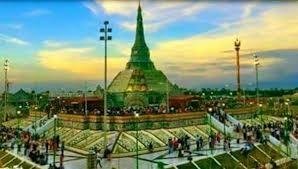
In Myanmar, a big pagoda named “Werawsana”, entirely built of one of Myanmar’s semi-precious stones, jade appeared in the present decade. It stands majestically on a hillock at Hsin Ywa, Myinhmu village tract in Amarapura Township, Mandalay Region, Upper Myanmar. It is easily visible and accessible on the good motor roads, to and fro Mandalay International Airport.
A year ago, the writer was invited by the Department of History, Mandalay University to give a series of lecture on Myanmar cultural history for Ph.D. Preliminary students. On arrival at Mandalay International Airport, students and staff of History Department who came to welcome the writer informed him of the said Jade Pagoda which was near completion and they suggested that the writer should visit it as it was just on the way to Mandalay. We visited it and the young guides well versed in both English and Myanmar explained us in detail about this world’s first Jade Pagoda. Besides, were presented each copy of the booklet on its history. 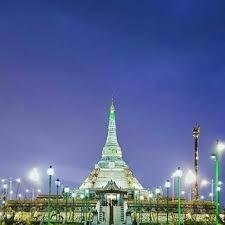
Two days later, the donor of this Jade Pagoda, U Soe Naing sent a young man with a car to the writer to invite the writer to his house from the breakfast of Mandalay Nangyi Monti (Noodle) we two had a parley of nearly two and a half hours, over a sumptuous breakfast of delicious Nangyi Monti plus a variety of Akyaw Sone (Fries). Like the writer, U Soe Naing is an anyatha (Upper Myanmar man) but much younger than the writer. He could be about his eldest son’s age. He said he had read some of the writer’s books and articles. At the writer’s request, he briefed on his early life and how he prospered through hand work, with honesty, perseverance, observance of five moral precepts (Pancha Sila of the good Buddhists) and loving kindness and constant dana (giving). His early life was quite tough. As a young lad he was employed as a daily wage earner in Jade mines in Kachin State. Hailed from the countryside in Pakokku Town which is in dry zone area, he had to withstand the cooler climate of Jade mine areas in addition to malaria. He not only survived but also began to rise from a mere wage-earner jade-digger to Jade trader and Jade mine owner. When he became quite a wealthy man known locally as “Kyauk-sein Thu Htay Gyi” (a rich man of jade trade) he was aware of the impermance of everything and every living creature as taught by Lord Buddha. From zero to billions he rose to become a young man of a great substance with a happy family, beautiful domestic wife, children with good education, kiths and kins, the entire village of his birth place and his workers he looks after well. He could well afford to live a luxurious life of a wealthy elite either at home or abroad. But he is always inspired to make an unusual dana (giving). For him nothing could be better and nobler than the dana of jade stones which had made him a wealthy man. So he decided to build a jade pagoda, the first of its kind in Myanmar history, or even in the world. All his family members, kiths and kins agreed. Therefore he began collecting jade stones of his choice for over 25 years. He selected jade stones of A, B, C, and D quality grade of international jade market. They weigh a total of over one thousand tons! 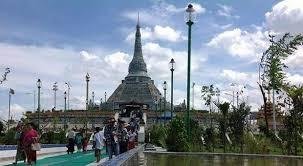
Though the writer was carried away with him on his armchair travelogue of his success story, U Soe Naing was also partaking with bonapetite, the Mandalay Monti he was so kind enough to feed the writer, a Mandalayan that morning. Only an early middle age, an active, forward-looking, honest and pious jade merchant of a great substance U Soe Naing has made his history. The writer harboured the wish to compile his biography. On return from Mandalay to Yangon the writer met him on the plane. He said he would send said he would send the writer an invitation to attend the hti hoisting (umbrella or crown putting on top of the Pagoda) ceremony in February of that year. But the writer was abroad so he missed his invitation. The following is an account of the world’s First Jade Pagoda, as recorded in the booklet we received. 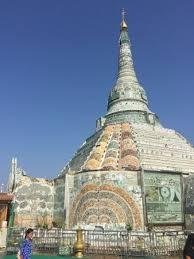
The title-name of the Jade
Pagoda
Shwe Thuwun Monk Sayadaw Bhaddanta Saddiya, Agga Maha Pandita, Agga Maha Saddhamma Jatika dhaja chose the title-name “Werawsana” for this Jade Pagoda. It was built for all peoples of Myanmar and all peoples of the world who worshipped it and paid homage to it. They all may receive all blessings, all Mingalas and enjoy peace. Therefore the title –name means given of peace, progress, prosperity, good fortune, glory, fame, wealth and immunity from all dangers, and wish-fulfilling.
The Site of the Jade Pagoda
Mandalay Region, Upper Myanmar, Amarapura Township, Hsin Ywa, Myinhmu village Tract Site No.628 to the west of 361mile pillar on the Yangon- Mandalay High way about 600 feet to the west, about 1,000 feet to the south of Sagaing. Myitnge motor road 4/7 mile pillar, a precinct on a hillock, measuring 133 feet 6inches long and 133 feet 6 inches wide- a perfect square. 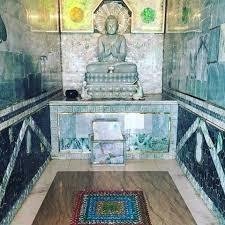
The donor-craftman and the expenditure
The donor of the site, as well as the manager of designing and covering of jade and sculpture is U Soe Naing (Aye Aye Khaing, Gems Company)
The total cost of construction up-to-date is over 40,000 lakhs and the value of jade stones used is at least over 100,000 lakhs.
The committees formed by the state government
On 23 October, 2012, the president office issued the notification No. 78/2012 forming the Steering Committee for the Construction of the Jade Pagoda. The Ministry of Religions Affairs issued the notification No. 3/2012, dated 27.10.2012 and No. 5/2012 dated 5.12.2012 forming Executive Sub- committees and the office of the Mandalay Regional government issued the letter No.2/4-8116 (980) dated 29.12.2013. The letter 2/4-8116 (980) giving operation order.
The aims and purposed of the construction of the Jade
Pagoda “Werawsana”
The world conference of all religions recognized that Buddhism is a religion based upon strong evidences and high moral concepts. It is based on “loving kindness” (metta). The missionaries who propagate are humans as such they will one day pass away. For example, from the earliest Aryan Buddhist missionaries down to Emperor Asoka of India, of Chandra Gupta Mauriyan, dynastic Empire, most countries in Europe and Asia were Buddhist countries where Aryan Buddhist missionaries propagated the teachings of Lord Gatama Buddha. When these Aryan Buddhist missionaries passed away the successor Governments no longer supported Buddhist missionaries. So Buddhism gradually declined in such countries.
Even in the history of Myanmar, Lei-di Sayadaw monk, Mahasi sayadaw monk, mogok Sayadaw monk came and gone. Today there are few Buddhist missionary monks like Sitagu Sayadaw monk, who are propagating Buddhism at home and abroad. But after them, it is hardly likely that their successors will emerge. Therefore to preserve and to prevent Buddhism from total decline and extinction, it is needed to make relentless efforts in advance.
Buddhist monuments (Pagodas, stupas, temples, monasteries, schools etc) are tangible objects important for the concrete evidences for its survival. Just as the impermance of lives of Aryan Buddhist missionary monks, these Buddhist monuments tangible objects, will also ruin and disappear from our planet “Earth”. Therefore it is highly important and very necessary to build monuments like very valuable pagodas such as Jade Pagoda “Ye-yaw-Sana”. These tangible objects will remain for a long time as strong evidence of Buddhism on this earth.
Myanmar, a country well known worldwide for producing the best quality jade. Jade is one of Nine Ratana Stones. (Nawarat Kopa) As it is a natural product, it is likely to be extinct one day, when its mines are exhaustively extracted. Therefore this Jade Pagoda is built to stand as a witness to show that Myanmar is the home of Jadite Jade.
Those who came to visit, see, revere, and worship this Jade Pagoda will be religiously inspired to take interest in Theravada Buddhism still flourishing in Myanmar since the earliest date of the arrival of the Teachings of Lord Gotama Buddha to Myanmar. In that way the spread and propagation of Buddhism will be further promoted the Jade Pagoda is to be built in Myanmar, the home of quality Jade mines. Jade Pagoda is the land mark of Myanmar, It is expected that sooner or later this Jade Pagoda will be engraved in the List of Guinness Book of World wonders or the UNESCO Cultural Heritage List. Due to this world’s First Jade Pagoda in Myanmar, Myanmar’s Hotels and Tourism Industry which is right now booming by leaps and bounds, will be further enhanced. Peoples across the world will come to learn the real condition and situation of the country and its ethnic peoples who are now unitedly on a kick off to reach the goal of a modern, peaceful, prosperous democratic state.
The year of construction
Before the construction took place, two ceremonies were held in accordance with the traditions of building religious monuments. The first was the Maha Mingala One. The cleansing and purification of the site took place on 21 December, 2012. Next the ground breaking ceremony was held on 23-12-2012. Monk Sayadaw, Brahmin priests and astrologers led the ceremonies.
The measurements of the Jade Pagoda
The Jade Pagoda is 75 feet 6 inches high, 176 feet in circumference, each terrace is 52 feet 6 inches long, 52 feet 6 inches broad and 12 feet high. The hti (decorative umbrella on the top of the Pagoda) is 7 feet high, the decorative banana bud is 8 feet 6 inches high. Four entrance cave facing four cardinal directions have each a jade Buddha statue in seating position. The jade Buddha statue housed in the east entrance cave is 49 inches high, that in the west entrance cave is 31 inches high, that in the north entrance cave is 50 and a half inches high and that in the south entrance cave is 49 and a half inches high.
The design of the jade pagoda
True to the typical Myanmar traditional design of a pagoda, this Jade Pagoda has four entrance caves, facing four cardinal directions. Four jade staircases on four sides are decorated with jade sculptures of Makan (mythical watery creatures} of young mango fruit [Thayet-Kin] and motifs of flames executed by Myanmar jade craftsmen of Aye Aye Khaing Jade and Gem Co. Thirty thousands jade Buddha statues each measuring 2 inches in circumference, adorn the entire body of the Pagoda.
In addition, the entrance caves are adorned with Myanmar decorative motifs—Take, U Kin, etc, all quality Jade stones sculpted by Myanmar craftsmen. There are also the scenes of the Buddha’s birth, his Enlightenment, his first sermon [Dhammacakya] and his Demise [Maha parinivana] depicted in jade stones on the upper penals of the terraces. On the middle and lower penals are sculptures in jade of scenes, depicting the ten Pan-ultimate lives of the Buddha, fulfilling ten perfections [Paramitaw] and also scenes depicting the 8 victories of the Buddha over his eight opponents [Aunggyin Shitpa].
The technology of the construction
To make the Jade Pagoda last as long as our planet Earth exists, the jade pagoda was constructed so that it can withstand an earthquake of 6.59 Richter scale. To enable it to meet heavy storms the bored pile technology was used. On the steel frame, iron nets and cement concretes were added.
No terra cotta bricks were used. Only jade bricks, fashioned out of the jade stones the donor himself carefully and painstakingly collected for over 25 years were used. The quality jade stones of A, B, C, D grades of international jade market, totaling over one thousand tons of weight were used to build this Pagoda 850 tons of quality jade stones are enshrined in the body of the Pagoda. The decoratic diamond bud on the canopy is made of quality jade.
The garden around the Jade Pagoda
For peaceful rest and relaxation of the visitors and pilgrims to the Jade Pagoda, a landscape garden is created around the jade pagoda. Flowering and fruiting trees, in the park around the jade pagoda are Myanmar native as well as some exotica. The donor selected Myanmar native trees, creepers and plants such as Neem, Padauk, Gantgaw, Ingyin, Ngu, Pauk, Yuzana, Seinban etc that produce healthy fragrance, pretty hues and medicinal and culinary buds, leaves and blooms, attracting winged creatures—bees, warps, butterflies, birds as well as squirrels and some reptiles.
Not very far from the Jade Pagoda will appear Monzaleinda Lake with a seated Buddha statue under the shelter of the hood of a Naga-serpent. On either side of it, will be set up the statue of Saint Ashin Siwali and Saint Ashin Upaguta. They will be sculpted out of jade stones. Corridors to circumambulate these statues will cross over the said lake.
The Five Properties of Jade
(a) Generosity (2) Courage (3) Sense and spirit of equality and justice (4) Humbleness and (5) Wisdom intelligence and learnedness.
Jade Dhamma Sala and other appertaining religious movements
To the south of the Jade Pagodam on a site of 80 feet long, 60 feet wide, a big Jade Dhamma Sala is being built. It has a spacious ground floor. Estimated cost for Park-garden kyats 500 Lakhs, for landfill kyats 6,534 Lakhs, for making car parking kyats 1,340 Lakhs, for electrification of indoors kyats 5,500 Lakhs, for electrification of outdoor 952 lakhs, for the construction of Dhamma Sala kyats 3,360 lakhs, for four archways kyats 1,000 lakhs, for prayer post [Tagun Taing] kyats 200 lakhs, for walls around the entire precinct kyats 600 lakhs, for the shire of Saint Shin Upaguta kyats 325 lakhs, for the shrine of Saint Ashin Siwali 75 lakhs, and Toilets and water supply kyats 1,750 lakhs.
There are three-storey hotels, and shop-houses, some completed, some still under construction, not very far from the Jade Pagoda precinct. Souvenir and gift shops are attached with workshops of artists, artisans and workers, most of whom reside in the nearby villages.
A big showroom and jade auction centre are also in the process of construction.
The whole area is being urbanized. In no time Hsin Ywa, Myinhmu village that would become a cute Jade Town of international renown.
I want to go there.
Downvoting a post can decrease pending rewards and make it less visible. Common reasons:
Submit
done
Downvoting a post can decrease pending rewards and make it less visible. Common reasons:
Submit
Hi! I am a robot. I just upvoted you! I found similar content that readers might be interested in:
http://www.globalnewlightofmyanmar.com/the-worlds-first-jade-pagoda-in-myanmar/
Downvoting a post can decrease pending rewards and make it less visible. Common reasons:
Submit
Good place for foreigner
Downvoting a post can decrease pending rewards and make it less visible. Common reasons:
Submit
Pls follow and vote
Downvoting a post can decrease pending rewards and make it less visible. Common reasons:
Submit
unmute ျဖစ္ေနလို႔ ခုမွ ျပန္ VOTE ရတယ္
Downvoting a post can decrease pending rewards and make it less visible. Common reasons:
Submit
😊
Downvoting a post can decrease pending rewards and make it less visible. Common reasons:
Submit
done sir
Downvoting a post can decrease pending rewards and make it less visible. Common reasons:
Submit